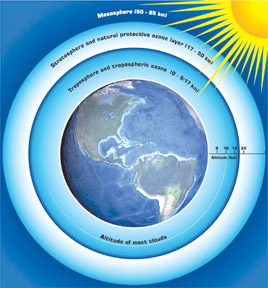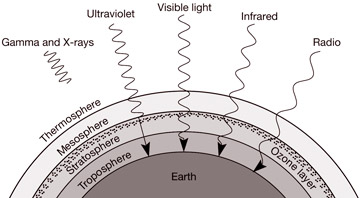|
Move to phase out HCFCs:
Lanka ahead in safeguarding ozone layer
By Dhaneshi YATAWARA
 In the late 1920s Thomas Midgley, an American mechanical engineer and
chemist synthesized Chlorofluorocarbons which soon replaced the various
toxic or explosive substances which were used then as refrigerants.
Today the world has stopped using Chlorofluorocarbons (CFCs) as they are
globally recognised as the main cause in depleting ozone layer. The
entire world moved from Chlorofluorocarbons to Hydrochlorofluorocarbon
in order to save the ozone layer which lies high above us in the sky
protecting the earth dwellers from harmful radiation coming from the
sun. Today the world is getting ready phase out Hydrochlorofluorocarbons
(HCFCs) as it affects Climate Change though recognised as a low ozone
depleting agent. In the late 1920s Thomas Midgley, an American mechanical engineer and
chemist synthesized Chlorofluorocarbons which soon replaced the various
toxic or explosive substances which were used then as refrigerants.
Today the world has stopped using Chlorofluorocarbons (CFCs) as they are
globally recognised as the main cause in depleting ozone layer. The
entire world moved from Chlorofluorocarbons to Hydrochlorofluorocarbon
in order to save the ozone layer which lies high above us in the sky
protecting the earth dwellers from harmful radiation coming from the
sun. Today the world is getting ready phase out Hydrochlorofluorocarbons
(HCFCs) as it affects Climate Change though recognised as a low ozone
depleting agent.
We just passed celebrating the Ozone day which falls on September 16
every year. The Theme this year is HCFC phase-out: a unique opportunity.
It was in 1974, American professor of chemistry Sherwood Rowland and
Mexican chemist Mario Molina pointed out the possibility of CFCs in
depleting the ozone layer. This is now considered as an early warning
which the earth dwellers missed. In 1984 British Antarctic Survey (BAS)
scientists first announced the discovery of the hole in the ozone layer
above Antarctica. Published by Joe Farman, Brian Gardiner and Jonathan
Shanklin in the journal Nature in May 1985, the findings provided an
early warning of the dangerous thinning of the ozone layer worldwide.
This led the world towards the Montreal Protocol. The first step, the
‘Vienna Convention for the Protection of the Ozone Layer’
According to worldwide researches, a single Chlorine atom can destroy
upto 100,000 ozone molecules. CFCs were used in refrigeration and air
conditioning systems, fire control and industrial solvents. Under the
1987 Montreal Protocol and its amendments, the production and
consumption of CFCs, halons, carbon tetrachloride and methyl chloroform
were phased out.
 Sri Lanka is safe. Amidst the high demands of a developing nation,
resulting increased levels of urban pollution, Sri Lanka is one of the
few countries with low emission levels of ozone depleting substances. In
the middle of global chaos to save ‘ozone’, we as a country have done
our best. According to the National Ozone Unit the annual per capita
consumption of ozone of a Sri Lankan is just 0.3 kilograms. Sri Lanka is safe. Amidst the high demands of a developing nation,
resulting increased levels of urban pollution, Sri Lanka is one of the
few countries with low emission levels of ozone depleting substances. In
the middle of global chaos to save ‘ozone’, we as a country have done
our best. According to the National Ozone Unit the annual per capita
consumption of ozone of a Sri Lankan is just 0.3 kilograms.
As we all know the ozone layer, which is approximately 15 km to 35 km
above Earth’s surface is in the lower levels of the second major layer
of Earth’s atmosphere a.k.a. the stratosphere. Formed millions of years
ago the ozone layer is part of the atmosphere couch that protects us
from harmful elements of the universe. It has been found that this layer
absorbs 97-99% of the sun’s high frequency ultraviolet light, which is
potentially damaging to life on earth. According to scientists and
researchers working across the globe, recovery of the ozone layer may
not be as simple as eliminating the manufacture of CFCs. Climate change
will alter ozone recovery because greenhouse gas increases will cause
the stratosphere to cool.
This cooling may temporarily slow the recovery of the ozone layer in
the polar regions, but will accelerate ozone recovery at low and middle
latitudes.
The multilateral Environment Agreement ‘Vienna Convention for the
Protection of the Ozone Layer’, which was agreed upon by almost all the
countries act as the framework for the international efforts to protect
the ozone layer. Vienna Convention entered in to action in 1988. The
treaty, the Montreal Protocol was opened for signature on September 16,
1987 which later entered in to force on January 1, 1989. The Montreal
Protocol represents a landmark in the successful reduction of global
production, use and emission of ozone depleting substances.
According to the United Nations most recent analysis of the costs and
benefits of the Montreal Protocol states avoiding 19.1 million cases of
non-melanoma skin cancer, 1.5 million cases of melanoma skin cancer, 120
million cases of cataracts and 238,000 million US dollars worth damage
to agriculture production. Today signed in the Montreal Protocol actions
are focused on limiting the production and consumption of HCFC in an
accelerated phase out plan to minimize emissions of refrigerants and
adoptions of low global warming potential alternatives for HCFCs,
whereever possible.
Sri Lanka became a signatory to the Montreal Protocol in 1989 and the
National Ozone Unit was set up in 1994 to carry out the mandate given by
the Protocol. Sri Lanka has done effective strategies to convert
companies and industries to adhere to ozone-friendly policies. In 2007
the Sri Lanka received the Implementers Award of the Montreal Protocol.
Sri Lanka Tea is today recognized as an ozone-friendly product is a
noteworthy achievement exemplary to other industries. Sri Lankan tea
industry stopped using Methyl Bromide which is an Ozone depleting
substance that was used in pest management and adopted to
environment-friendly technologies. Earlier Methyl Bromide CH3Br is
imported as a fumigant and to control a wide range of pests. It was used
as a soil treatment to control soil pests such as Nematodes, Seeds
fungi, bacteria and other parasite plants. Since Sri Lanka is not
producing any of the Ozone depleting substances, consumption is based on
imports.
 Depletion of the Ozone layer will result in UV radiation filtering
through the Troposphere. Depletion of the Ozone layer will result in UV radiation filtering
through the Troposphere.
This UV radiation will react with Oxygen (O2 ) and create Ozone (O3)
at the Troposphere where it is harmful to humans, crops and other living
creatures.
Therefore a lot is at stake for the survival of the human race. To
protect the earth and its inhabitants the task ahead should not be
prolonged or taken lightly.
The world community has not yet felt the full impact of ozone
depletion. Therefore it is important to take preventive action before we
experience the full impact of ozone depletion. Ultra violet rays have an
adverse effect on plant and marine life.
There are also serious impacts for biodiversity. Increased UV-B rays
reduce levels of plankton in the oceans and subsequently diminish fish
stocks.
It can also have adverse effects on plant growth, thus reducing
agricultural productivity. Another negative effect is the reduced
lifespan of certain materials. Seeds of plants and larvae of sea
creatures that are exposed to the sun will be seriously damaged thereby
breaking the natural life system and food production. Growth of plants
and crops will also be restricted. In a developing country like Sri
Lanka effects of these changes will be aggravated by the poor health
condition, undeveloped agricultural methods and other economical set
backs.
|

